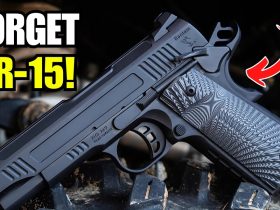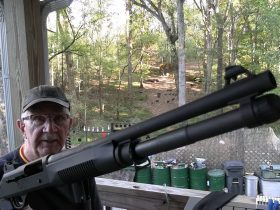Many gun owners who begin carrying their handguns concealed outside the home don’t do so for very long. Either they wind up carrying their guns infrequently or often they just give up altogether. People who stop carrying daily don’t quit because their guns are too heavy or too complicated, they quit because their setup makes daily carry miserable. I’ve seen it countless times: Someone buys a quality pistol, loads it with good ammo and then stuffs it into a cheap, poorly designed holster. Within a week, the gun is in the glovebox or left at home instead of on their belt. The problem isn’t the firearm, it’s the system.
The holster is often the weakest link in an otherwise solid setup. It can dig, shift or print through clothing, making the carrier constantly aware of its presence and eventually becoming frustrated and stop carrying altogether. Sometimes the issue is caused by a quality holster, but one attached to an unsuitable belt. Other times it’s the cover garment, holster and belt not working well together. Getting the right combination of holster, belt, and cover garments transforms carry from a chore into second nature.
The Foundation: Understanding Carry Positions
It is important to understand how holster carry position affects draw, comfort and concealment. Every position has its pros and cons, and none are universally the best option for all contexts.
Inside the waistband on the hip is a common carry position.
Strong-side Inside-the-waistband (IWB) is perhaps the most common carry position in America today. IWB connotes a holster that rides inside the waistband of the pants, typically around 3-4 o’clock on the right hip for right-handed shooters, and 8-9 o’clock on the left hip for southpaws. IWB holsters usually attach to a belt via various loops or clips. This carry position balances concealment and access for most body types. The gun rides close to the body, reducing printing, but can be uncomfortable if the holster has poor contouring, if your belt lacks structure or if the belt and gun are worn too low or too high. Ride height and holster cant matter more than most realize. A half inch too high or too low can be the difference between “disappears under a T-shirt” and “I’ll never carry again.”

Appendix carry gives you a lot of room to conceal your firearm.
Appendix-Inside-the-Waistband (AIWB) has exploded in popularity because it offers a fast, consistent draw and excellent concealment, as well as excellent holster/concealment awareness. So named because the holster typically sits IWB at roughly 2 o’clock on the waistline for right-handed shooters over their appendix, in truth AIWB is any IWB carry forward of the hips for shooters of either hand, as there is wide variance of the ideal position for individual body types. Body type, posture, and clothing all factor in. Someone with a larger midsection may find appendix carry uncomfortable when seated for prolonged periods. The solution isn’t to write it off; it’s to experiment with holster shape, wedge placement and ride depth until it fits your frame.
Outside-the-Waistband (OWB) is what most people new to carry think of when they think of holsters and is typically the most comfortable and natural for many shooters. However, it requires the most deliberate concealment of waist-centric carry methods. Unless you’re wearing a jacket, OWB often means printing or possible exposure during normal movement. For winter carry, though, it’s hard to beat, so long as you can leave your jacket on or have a large enough cover garment to conceal it with jacket removed. A good OWB holster with proper retention offers unmatched comfort and is typically faster than strong-side IWB.
Other options like pocket carry, shoulder holsters or ankle holsters each have their niche, but all come with trade-offs in access speed, retention or firearm size. The key is honesty: What you want to carry isn’t always what your wardrobe or daily life will allow, and the goal is to get the best trade-off you can where you have a gun on you that you can rapidly access in an emergency, yet having the gun on you is a natural part of your life rather than an uncomfortable hassle.

Your holster is just part of a system of concealed carry.
Holster Criteria
A safe and quality holster should meet the following criteria:
- The holster is purpose-built for your make and model of firearm. “Universal” holsters are to be avoided for daily concealed carry.
- The holster completely covers the trigger guard so that the trigger cannot be pressed while the gun is holstered.
- When mounted on the belt in the chosen carry position, the holster retains the gun so that the only way it comes out of the holster is if you deliberately draw it. It should not fall out of the holster, or even partially shift in the holster, due to running, jumping, falling, getting down on or up off the ground, or any other vigorous movement.
- The mouth of the holster should remain open even when the holster is empty. If the holster flattens out when empty, requiring you to use your free hand to pry the holster mouth open to holster, this can easily lead to muzzling your own hand and other unacceptable risks.
The Belt: The Unsung Hero
If there’s one piece of gear that quietly determines success or failure, it’s the belt. I’ve seen many students ditch the cheap holster for a quality offering but then attach that quality holster to a department-store belt that is not purpose-built for concealed carry. A weak belt turns even the best holster into a liability. It allows the gun to tilt outward, sag or shift during movement. That movement isn’t just annoying; it limits concealment, comfort and the inconsistent positioning can lead to inconsistency in your draw stroke. Consistency is the key to comfort and competence.
A proper gun belt has the appropriate degree of stiffness to distribute weight evenly and maintain a consistent holster position under stress. Leather looks good and can perform well if it’s double-layered and reinforced. Nylon belts with internal stiffeners offer consistent support. The key is structure. A floppy department-store belt isn’t made to hold up to 30 ounces of steel and polymer, not to mention everyday-carry tools like spare magazines or other items you may want to attach. What ends up happening is the belt stretches and falls apart, and the new concealed carrier can’t figure out why they aren’t having better luck with comfort and concealment of their quality gun and holster. Get a belt that is purpose-made for concealed carry and many of your carry problems disappear.
The Cover Garment Variable
Your cover garment determines not only what you can conceal, but how you can access it. Most people think “cover garment” just means “shirt,” but there’s a critical difference between a closed-front and an open-front garment, and that difference should guide your carry setup.
A closed-front cover garment is any piece of clothing that doesn’t open down the middle when worn. That includes T-shirts, polos, sweatshirts, and jackets or button-down shirts when they’re zipped or buttoned up. To access the gun, you must lift the garment straight up. That motion favors appendix or strong-side IWB carry because the muzzle sits inside the waistband reducing the snagging hazard and the grip is easy to expose by sweeping the shirt upward. It also rewards shorter grips and flatter holsters that don’t print when the fabric drapes over them. If you typically dress in T-shirts or keep your outer shirt buttoned or jacket zipped, your holster should support a clean upward draw, and IWB or AIWB carry is ideal for this type of garment.
An open-front garment is one that hangs loose and is worn unzipped or unbuttoned, such as an overshirt, vest or sport coat. These allow you to clear the garment laterally with a sweep of the hand, which makes 3 o’clock and behind-the-hip carry more viable. Open-front garments move naturally with the body and help break up outlines, making larger pistols and OWB holsters easier to conceal, however, they can open up with an errant breeze, exposing your firearm for all to see.
Your daily wardrobe should shape your holster choice more than advertising or trends. Before you buy anything, take an honest look at how you dress most days. If you live in closed-front clothes, prioritize holsters optimized for an upward sweep of the cover garment. If you routinely wear open-front garments, you have more flexibility with holster placement and gun size. The right setup complements how you already live instead of forcing you to dress around the gun.
Conclusion
Concealed carry can seem like a hassle, but with the proper steps and a systematic approach, it can be a comfortable and natural part of our lives that ensures we are ready should we ever need a handgun to protect our loved ones or ourselves. We need to understand the strengths and weaknesses of the various carry methods (IWB, AIWB, and OWB), consider our typical wardrobe and ensure we choose a proper, high-quality holster and purpose-built belt on which to attach it. Then it’s just a matter of making slight adjustments to the system until you’re carrying daily as part of your routine without discomfort, printing, or all the other annoyances that lead so many to leave their handgun at home.
Read the full article here

















Leave a Reply